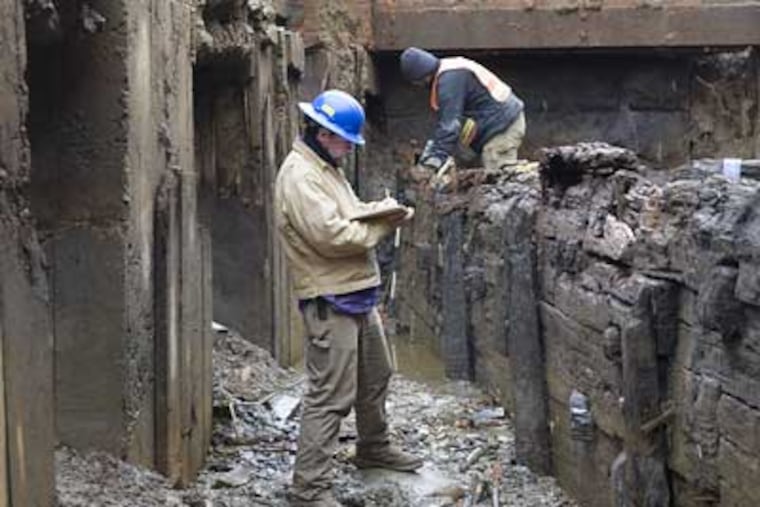Wall provides link to canal's past
The watery tomb held its secret for more than a century. And it would have stayed that way if not for plans to build a new Girard Avenue ramp off I-95 in Kensington.

The watery tomb held its secret for more than a century.
And it would have stayed that way if not for plans to build a new Girard Avenue ramp off I-95 in Kensington.
Archaeologists working for the Pennsylvania Department of Transportation have uncovered a relic from Philadelphia's commercial past that one historian called fantastic.
In a muddy pit under a lattice of elevated I-95 lanes, next to the Port Richmond Village shopping center, they have excavated a 50-foot stretch of wooden wall from the Aramingo Canal.
Built in 1847, the canal was a footnote in the evolution of Kensington as a commercial hub. With trains eventually eclipsing barges for hauling materials, the canal became an obsolete, polluted nuisance. It was completely covered over by 1902, becoming Aramingo Avenue.
Archaeologists knew where to look for the canal. But what they didn't realize was that they would find a section so perfectly preserved that they could still see the ax marks in logs.
Douglas Mooney, a senior archaeologist for URS Corp. Inc., said an underground stream - the long-forgotten Gunnar's Run - has kept the wooden wall waterlogged, sparing it from microbes that could have destroyed it.
"It's rock solid," Mooney said. "Sometimes you just get lucky."
Neighborhood historians are cheered by the discovery. They hope it will spur more interest in the waterfront's 19th-century industrial legacy, which tends to be overshadowed by the city's marquee colonial past.
Mooney, who also serves as president of the Philadelphia Archaeological Forum, said the riverfront had languished as a "historical backwater."
"It's just never had the same panache as Center City Philadelphia," said Mooney, who also worked on the excavation of George Washington's house and the Constitution Center site.
But that is changing, Mooney said. "There is an eagerness in neighborhoods to tell their individual histories," he said.
Nowhere is that clearer than in the lower river wards of Kensington, Fishtown and Port Richmond.
"It's an exciting time for our community," said Ken Milano, a historian who has written several books about Kensington.
Less than a mile from the I-95 project is another active archaeological site at the proposed SugarHouse casino location in Northern Liberties and Fishtown.
Archaeologists found hundreds of Native American relics on the SugarHouse property, and neighborhood historians have uncovered maps showing that the site had a British fort in 1777. Prodded by local interest, SugarHouse has agreed to look for evidence of the British redoubt.
Cathy Spohn, an archaeologist for PennDot, said the Aramingo Canal was unusual for two reasons. "Most canals were stone-lined and this one is wood," she said. "And it's so well-preserved."
The slow-moving stream that protected the canal wall underground also has created challenging conditions for archaeologists. Every day, the crew has to pump several feet of water from the site, Mooney said.
"Most of the time we're battling water and mud," he said.
Milano said that when the Aramingo Canal was built, the Delaware River waterfront was "an incubator for the Industrial Revolution."
There were shipbuilders, sawmills, lumber yards, rolling mills, lead works, glassworks, coal yards, and steam-engine shops.
"You had everything you needed to build iron ships right there," Milano said. "And if you wanted to learn the trade of steam-engine building, you started here."
The Aramingo Canal flowed into the Delaware River near where the current Beach Street merges into Richmond Street.
In 1847, investors paid $100 a share to join the company building the five-mile canal. But the backers had only enough money to finish one mile.
The canal became a money pit for its owners. It lacked a natural water source and was heavily polluted. A slaughterhouse at the far end of the canal dumped carcasses into the water.
"Within 20 years, this was little more than an open sewer," Mooney said. "The water was inky black and there was two feet of black mud at the bottom."
Doctors blamed the foul waterway for outbreaks of malaria and typhoid. "This became a health nightmare," Mooney said. The city began filling in the canal in 1896.
The excavation began six weeks ago but is now winding down. Archaeologists have been measuring and photographing the canal wall. PennDot may publish an account of the project for the public.
In the days ahead, Mooney said, the crew will bury the wall again to prevent damaging the logs by exposing them too long to air.
"We don't want to lose it," he said.
And so it's back to a muddy crypt for the Aramingo Canal.